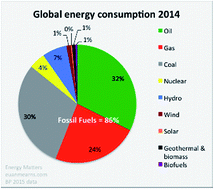当前位置:
X-MOL 学术
›
Sustain. Energy Fuels
›
论文详情
Our official English website, www.x-mol.net, welcomes your feedback! (Note: you will need to create a separate account there.)
Hydrogen derived from water as a sustainable solar fuel: learning from biology
Sustainable Energy & Fuels ( IF 5.6 ) Pub Date : 2018-03-23 00:00:00 , DOI: 10.1039/c8se00002f James Barber 1, 2, 3
Sustainable Energy & Fuels ( IF 5.6 ) Pub Date : 2018-03-23 00:00:00 , DOI: 10.1039/c8se00002f James Barber 1, 2, 3
Affiliation

|
The United Nations Climate Change Conference (COP21) held in Paris in 2015 and the follow-up conferences in Marrakesh (COP22) and very recently in Bonn (COP23) have established an unprecedented international agreement that during this century human society must break from its reliance on energy from fossil fuels to energy sources, which do not release greenhouse gases, particularly carbon dioxide. This is a very hard call. It will not only involve improving more efficient use of energy but also the establishment of new technologies and infrastructures for its generation and distribution. Among renewable energy resources able to tackle these challenges significantly are nuclear or those derived from solar radiation. However in the case of nuclear fusion, a technological breakthrough is required while nuclear fission is limited in the long run by the finite supply of uranium fuel. Here I focus on solar energy which is already contributing to the challenge of COP21. In particular, I discuss its capture and storage through the splitting of water to produce oxygen and hydrogen reducing equivalents, which is essentially the route taken by biology about 3 billion years ago. In so doing I will describe how Nature goes about achieving this fundamental energy converting reaction as a back drop to efforts to achieve the same goal using non-biological photo-electrochemical technology.
中文翻译:

来自水的氢作为可持续的太阳能燃料:从生物学中学习
2015年在巴黎举行的联合国气候变化会议(COP21)以及在马拉喀什(COP22)和最近在波恩(COP23)举行的后续会议已经建立了前所未有的国际协议,即在本世纪中人类社会必须摆脱对它的依赖从化石燃料转化为能源的能源,这些能源不会释放温室气体,尤其是二氧化碳。这是一个非常困难的电话。它将不仅涉及改善能源的更有效利用,还涉及建立新技术和基础设施以产生和分配能源。能够有效应对这些挑战的可再生能源包括核能或太阳辐射产生的资源。但是在核聚变的情况下 从长远来看,由于铀燃料的有限供应,核裂变受到限制,因此需要技术突破。在这里,我重点介绍已经对COP21挑战做出贡献的太阳能。特别是,我讨论了通过分解水产生氧气和氢气的还原当量来捕获和存储它的方法,这基本上是大约30亿年前生物学所采用的路线。通过这样做,我将描述自然如何实现这一基本的能量转换反应,作为使用非生物光电化学技术实现相同目标的努力的背景。我讨论了通过水分解产生氧气和氢气的减少当量的捕获和存储方法,这基本上是大约30亿年前生物学所采用的路线。通过这样做,我将描述自然如何实现这一基本的能量转换反应,作为使用非生物光电化学技术实现相同目标的努力的背景。我讨论了通过水分解产生氧气和氢气的减少当量的捕获和存储方法,这基本上是大约30亿年前生物学所采用的路线。通过这样做,我将描述自然如何实现这一基本的能量转换反应,作为使用非生物光电化学技术实现相同目标的努力的背景。
更新日期:2018-03-23
中文翻译:

来自水的氢作为可持续的太阳能燃料:从生物学中学习
2015年在巴黎举行的联合国气候变化会议(COP21)以及在马拉喀什(COP22)和最近在波恩(COP23)举行的后续会议已经建立了前所未有的国际协议,即在本世纪中人类社会必须摆脱对它的依赖从化石燃料转化为能源的能源,这些能源不会释放温室气体,尤其是二氧化碳。这是一个非常困难的电话。它将不仅涉及改善能源的更有效利用,还涉及建立新技术和基础设施以产生和分配能源。能够有效应对这些挑战的可再生能源包括核能或太阳辐射产生的资源。但是在核聚变的情况下 从长远来看,由于铀燃料的有限供应,核裂变受到限制,因此需要技术突破。在这里,我重点介绍已经对COP21挑战做出贡献的太阳能。特别是,我讨论了通过分解水产生氧气和氢气的还原当量来捕获和存储它的方法,这基本上是大约30亿年前生物学所采用的路线。通过这样做,我将描述自然如何实现这一基本的能量转换反应,作为使用非生物光电化学技术实现相同目标的努力的背景。我讨论了通过水分解产生氧气和氢气的减少当量的捕获和存储方法,这基本上是大约30亿年前生物学所采用的路线。通过这样做,我将描述自然如何实现这一基本的能量转换反应,作为使用非生物光电化学技术实现相同目标的努力的背景。我讨论了通过水分解产生氧气和氢气的减少当量的捕获和存储方法,这基本上是大约30亿年前生物学所采用的路线。通过这样做,我将描述自然如何实现这一基本的能量转换反应,作为使用非生物光电化学技术实现相同目标的努力的背景。


























 京公网安备 11010802027423号
京公网安备 11010802027423号